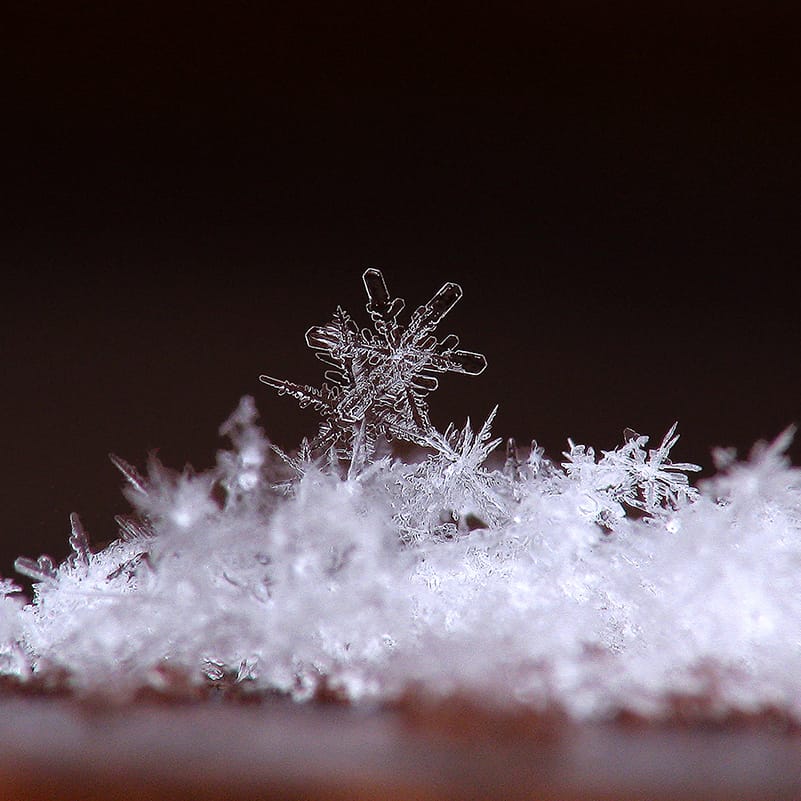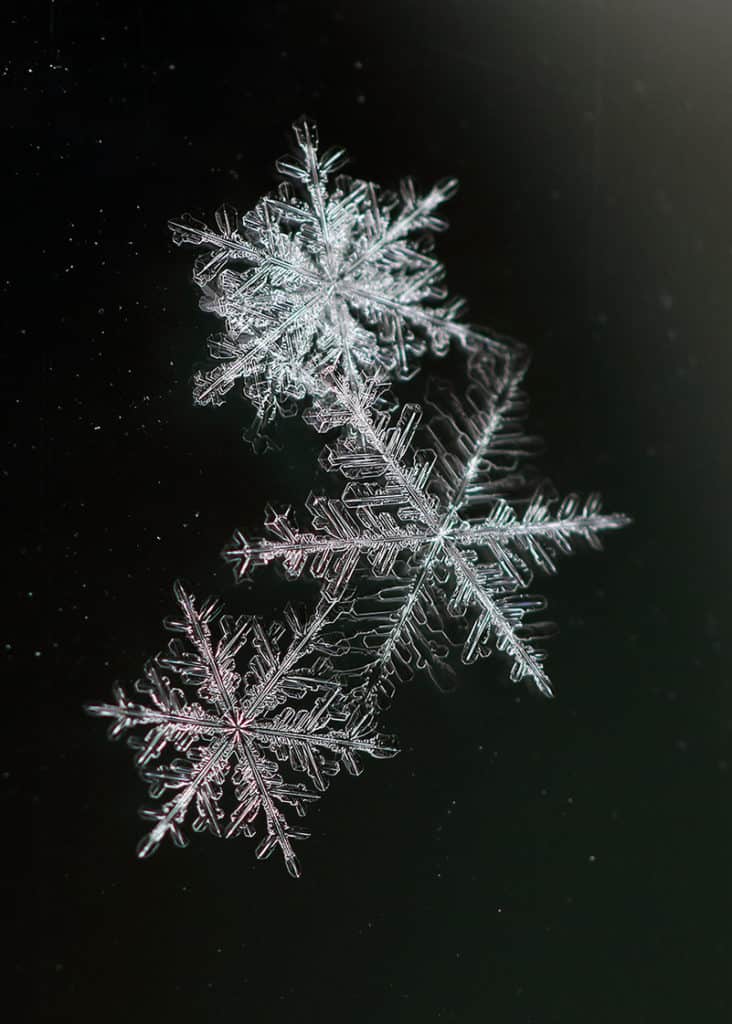By Joseph Miller | December 23, 2019
Long before William Bentley pioneered the photomicrography of snowflakes, people were intrigued by these beauties.
To the Japanese Ukiyo-e artists, snow was a force of beauty and contemplation. During the middle ages, inhabitants of the Alps associated snow with evil and witchcraft. In 1565, renaissance painter Pieter Bruegel created what is regarded as the first winter landscape painting. Later, in the 18th century era of romanticism, artistic works gave snow rather sinister and dangerous roles.
The Bible often uses snow to symbolize purity and forgiveness. In the book of Isaiah, God promises to restore the wayward tribe of Judah, provided they cease from evil and seek justice. “Though your sins are as scarlet, they will be as white as snow.” This message, ‘repent and be forgiven,’ applies to all people. Guilt from the past and feelings of unworthiness, like crimson stains, are difficult to overlook. But thanks to God’s grace, we’re made as white as snow before Him.
Snowflake Formation
Scientists are currently trying to understand how to build and direct the growth of snowflakes. Research in this area will help them learn how to grow other types of crystals for applications in the semiconductor industry.
A snowflake begins to form around a speck of dust or pollen particle floating through the sky. The crystals grow in symmetrical six-sided shapes because they are organized by molecular bonds which reflect the order of the water molecules (H2O).
Water molecules have three atoms in total: one Oxygen and two Hydrogen atoms. The bonds between oxygen and hydrogen are angled at 104.5 degrees, which gives the molecule its Mickey Mouse configuration. “Since water is a nonlinear, or bent, molecule, the difference in electronegativities between the oxygen and hydrogen atoms generates the partial negative charge near the oxygen and partial positive charges near both hydrogens” (Biology – LibreTexts). This is what gives water polarity. Everything about the symmetry of the snowflake is due to the polarity of water.

As water molecules bond, the slightly negative oxygen of one water molecule attracts the slightly positive hydrogen of another water molecule. The result is a microscopic hexagonal lattice, i.e. a baby snowflake! The edges of the lattice offer more points for attachment, so the sides quickly fill in while the edges form six different points. The arms begin to form at the six different corners because they stick further out into the air than the sides, this means diffusing water molecules hit the corners sooner and more frequently.
Soon, the six different arms form intricate branches, giving the snowflake its distinct look. All the branches grow at the same rate because each arm experiences the same air pressure, humidity and temperature.

Uniqueness
You’ve heard that no two snowflakes are alike.
This is partly true. Six-legged star-like crystals grow in air warmer than 26.6°. Between 26.6° and 14°, snow falls as miniature prisms. Little stars form Between 14° and -7.6°, and at lower temperatures, miniature prisms again. Snowflakes also come in different types. Most snowflakes form one of about 35 basic patterns. Studies suggest that less than 0.1% of snowflakes exhibit the six-fold symmetric shape.
The reason no two snowflakes are exactly the same (even though two may appear identical), has to do with the number of molecules. A typical snowflake contains a staggering number of water molecules, approximately 10,000,000,000,000,000,000—that’s 10 quintillion! The probability of that many molecules bonding the same way twice is essentially zero! In addition, each snowflake grows at different rates and patterns due to variability in the temperature and humidity of the air that it passes through as it falls to the ground.

Order vs. Design
Evolutionists claim that snowflakes are an example of order arising from disorder. They reason that snowflakes self-assemble, so life could similarly have arisen by molecules simply organizing themselves.
While it’s true that snowflakes exhibit order, they cannot be compared to living cells. Snowflake formation requires no more added information than what is found in their component parts. The existing properties of the molecules and appropriate atmospheric conditions are enough to cause a snowflake.
Life on the other hand requires additional information and sophisticated mechanisms to interpret that information. The organic molecules of living organisms have no tendency to organize themselves into functional cells. Life requires intelligence to add information and program it into mechanisms to take over the random processes of nature.
Based on what we know about the nature of God from scripture, Christian’s aren’t surprised to find order both in life-less forms and multi-celled organisms. But it is exciting to find beauty and tidiness in things as seemingly ordinary as snowflakes!
“For every house is built by someone, but the builder of all things is God.”-Hebrews 3.4.
Snow and the Bible
Through Isaiah the prophet, God compares the sins of Judah to the scarlet color of blood. But He offers forgiveness if Judah repents and heeds God’s words. “Come now, and let us reason together,” Says the Lord, “Though your sins are as scarlet, they will be as white as snow; Though they are red like crimson, they will be like wool.” (Isaiah 1:18, NASB). This word picture illustrates an essential idea of scripture: forgiveness.
When mankind chose to reject God, sin and corruption entered His perfect creation. Sin is like a scarlet stain, difficult to get out. Without God, sin is impossible to remove. To restore the lost relationship with His creation (Genesis 3:15), God promised to provide a way of redemption. He did this by sending His one and only Son to the earth. By sacrificing Himself and dying on the cross Jesus’ paid the price for sin.
Those who recognize their need for Jesus and seek forgiveness are in God’s eyes as pure as freshly fallen snow. When you see a mound of brilliant powdery snow, it’s a reminder of the washing away of sin, thanks alone to Jesus.

We pray you’re touched in new ways this year as you reflect on the first Christmas. The Old Testament prophecies foretelling the arrival of Jesus point to a distinct moment in God’s plan. This is the moment God became one of us. Emmanuel, “God with us,” though, means more than Jesus’ bodily presence on earth. “God with us” also points to the result of Jesus’ willing, sacrificial death, which is restored relationship with God.
“Praise be to the Lord, the God of Israel, because he has come to his people and redeemed them.” –Luke 1:68.
Sources
Tampier, Martin. “The Treasures of the Snow.” Creation Ministries International. Creation 32(2):33-35, April 2010. https://creation.com/treasures-of-snow/.
“Creation question: Snowflakes.” Creation 17(1):26-27, December 1994.
https://creation.com/creation-question-snowflakes/.
Parsons, Danielle. “READ: Snowflake Self-Organization.” Wonder Science. March 12, 2019.
https://wonderscience.com/latest/snowflake-self-organization/.
Wikipedia. “Snowflake.” https://en.wikipedia.org/wiki/Snowflake/.
Boundless. “2.2A: Water’s Polarity.” Biology – LibreTexts.
English, Charlie. “A brief history of snow.” The Guardian. 7 Jan 2010.
The Bible. Genesis 3:15. (NASB).
The Bible. Luke 1:68. (NASB).
The Bible. Isaiah 1:18. (NASB).
Social Share